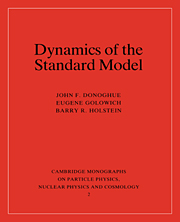Book contents
- Frontmatter
- Contents
- Preface
- I Inputs to the Standard Model
- II Interactions of the Standard Model
- III Symmetries and anomalies
- IV Introduction to effective lagrangians
- V Leptons
- VI Very low energy QCD – pions and photons
- VII Introducing kaons and etas
- VIII Kaons and the ΔS = 1 interaction
- IX Kaon mixing and CP violation
- X The Nc-1 expansion
- XI Phenomenological models
- XII Baryon properties
- XIII Hadron spectroscopy
- XIV Weak interactions of heavy quarks
- XV The Higgs boson
- XVI The electroweak gauge bosons
- A Appendix – Functional integration
- B Appendix – Some field theoretic methods
- C Appendix – Useful formulae
- References
- Index
II - Interactions of the Standard Model
Published online by Cambridge University Press: 06 January 2010
- Frontmatter
- Contents
- Preface
- I Inputs to the Standard Model
- II Interactions of the Standard Model
- III Symmetries and anomalies
- IV Introduction to effective lagrangians
- V Leptons
- VI Very low energy QCD – pions and photons
- VII Introducing kaons and etas
- VIII Kaons and the ΔS = 1 interaction
- IX Kaon mixing and CP violation
- X The Nc-1 expansion
- XI Phenomenological models
- XII Baryon properties
- XIII Hadron spectroscopy
- XIV Weak interactions of heavy quarks
- XV The Higgs boson
- XVI The electroweak gauge bosons
- A Appendix – Functional integration
- B Appendix – Some field theoretic methods
- C Appendix – Useful formulae
- References
- Index
Summary
A gauge theory involves two kinds of particles, those which carry ‘charge’ and those which ‘mediate’ interactions between currents by coupling directly to charge. In the former class are the fundamental fermions and nonabelian gauge bosons, whereas the latter consists solely of gauge bosons, both abelian and nonabelian. The physical nature of charge depends on the specific theory. Three such kinds of charge, called color, weak isospin, and weak hypercharge, appear in the Standard Model. The values of these charges are not predicted from the gauge symmetry, but must rather be determined experimentally for each particle. The strength of coupling between a gauge boson and a particle is determined by the particle's charge, e.g. the electron-photon coupling constant is –e, whereas the u-quark and photon couple with strength 2e/3. Because nonabelian gauge bosons are both charge carriers and mediators, they undergo self-interactions. These produce substantial nonlinearities and make the solution of nonabelian gauge theories a formidable mathematical problem. Gauge symmetry does not generally determine particle masses. A fermion mass term, although violating chiral symmetry, is consistent with gauge invariance. Although gauge-boson mass would seem to be at odds with the principle of gauge symmetry, the Weinberg-Salam model contains a dynamical procedure, the Higgs mechanism, for generating mass for both gauge bosons and fermions alike.
Quantum Electrodynamics
Historically, the first of the gauge field theories was electrodynamics. Its modern version, Quantum Electrodynamics (QED), is the most thoroughly verified physical theory yet constructed.
Information
- Type
- Chapter
- Information
- Dynamics of the Standard Model , pp. 24 - 68Publisher: Cambridge University PressPrint publication year: 1992
Accessibility standard: Unknown
Why this information is here
This section outlines the accessibility features of this content - including support for screen readers, full keyboard navigation and high-contrast display options. This may not be relevant for you.Accessibility Information
- 3
- Cited by
